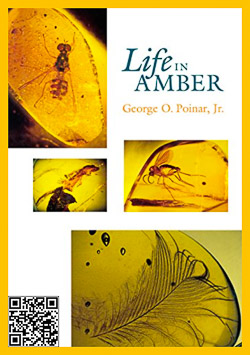Life in Amber
Amber is a semi-precious gem that is formed over eons by natural forces out of the resin of trees. Human fascination with amber dates back to prehistoric times, when it was probably considered to have magical powers and was used for adornment and trade. Amber amulets and beads dating from 35,000 to 1,800 B.C. have been found, and where they have been found (for example in graves hundreds of miles from their chemically determined origins) has often helped to establish ancient trade routes.
The preservative qualities of plant resins were well known by the ancients. The Egyptians used resins to embalm their dead, and the Greeks used them to preserve their wine. Amber often preserved fossils, frequently in a pristine state, of all kinds of animal and plant organisms that made contact with the sticky substance and became trapped in it. These fossils include such fragile organisms as nematodes and mushrooms that ordinarily are not preserved under normal processes of fossilization, as well as larger organisms like scorpions and lizards, and the fossils are preserved in their full three-dimensional form, complete with minute details of scales, mouth parts, antennae, and hairs. It has even been suggested that viable DNA may persist in some amber-trapped organisms.
